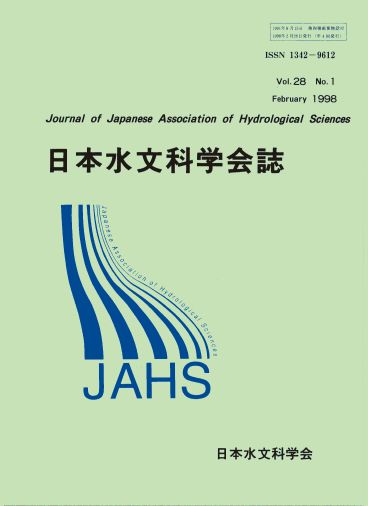
- 4 号 p. 125-
- 3 号 p. 83-
- 2 号 p. 45-
- 1 号 p. 1-
- |<
- <
- 1
- >
- >|
-
谷口 真人1998 年 28 巻 1 号 p. 1-12
発行日: 1998年
公開日: 2019/01/07
ジャーナル フリーAn overview of studies on mass and heat transports due to groundwater flow has been made. Evaluations of groundwater flow system, recharge and discharge areas, and capture and release zones, are keys to understand the mass and heat transports in subsurface hydrological regime. Groundwater flow and mass/heat transports should be studied including the effects of interaction between surface water and groundwater, and global environmental issue such as global warming on subsurface thermal regime. A link model of groundwater flow and solute transport with data base and GIS enable us to evaluate the effects of land use change and pumping on subsurface water, mass and thermal regimes. This kind of link model is useful to predict the change in hydrological environment, therefore, it will be a good tool for water, land use and environmental managements.
抄録全体を表示PDF形式でダウンロード (13767K)
-
樋口 篤志, 嶋田 純, 田中 正1998 年 28 巻 1 号 p. 13-22
発行日: 1998年
公開日: 2019/01/07
ジャーナル フリーThe purpose of this study is to investigate the groundwater flow system around the Takayubaru upland area which are located in the south western foot of Aso Volcanoes in Kyushu, Japan. The groundwater flow systems were analyzed by water qualities and potential distributions. The results are summarized as follows:
1) Groundwater in Takayubaru-lava flows through two layers which are divided by the Futa-Layer, the representative local aquiclude. Groundwater flow direction in the upper layer is from ENE to WSW, which are mostly controlled by the topographic feature of the Futa-Layer. While groundwater flow direction in the lower layer is from SE to NW, which is thought to be connected to the Aso somma aquifer.
2) The groundwater flow of main aquifer in the study area is controlled by the topographic feature before the Aso pyroclastic flow accumulation. However, this study can not confirm the presence of groundwater valley which is called “Mizumichi” in the previous studies. The groundwater potential in Takayubaru-lava investigated by this study can make clear the precise distribution of piezometric heads in and around this study area.
3) This study uses concentrations of sulfate ion as the groundwater tracers, because the groundwater in the recharge area has high concentration of sulfate ion. From this analysis and seasonal changes in groundwater qualities, it is cleared that the groundwater recharged by the rice paddy field within the Kikuchi upland flows though the upper layer of main aquifer in this study area.
抄録全体を表示PDF形式でダウンロード (35327K) -
宮下 雄次, 田瀬 則雄, Vythiringam NANDAKUMAR1998 年 28 巻 1 号 p. 23-36
発行日: 1998年
公開日: 2019/01/07
ジャーナル フリーThe tropical monsoon area has the intense seasonal and areal variations of rainfall amount according to the change of seasonal wind direction. The seasonal variations of moist condition on the surface affect the groundwater and it’s water quality.
The hydrochemical evolution of groundwater was investigated from the variations of groundwater quality and stable isotopes in the central western area of Sri Lanka. In order to compare the isotopic values of precipitation and groundwater, the rainfall amount and δ18O at observation well point were calculated from observed and measured values at five meteorological stations.
The results of comparisons between the average values of isotopic composition of precipitation and groundwater, the groundwater showed relatively low δ18O values. The concentrations of dissolved ions in groundwater and it’s isotopic composition varied inversely as the groundwater level.
The relative low δ18O values of groundwater indicated that the precipitation of relatively high δ18O values in the dry season did not recharged on the groundwater. The weighted mean of the precipitation over 100 mm / month showed the close values to the groundwater.
On the assumption that the isotopic compositions and concentration of dissolved ions of groundwater in the dry season varied by graduation, the rate of it’s concentration was calculated from the change of the δ18O and Cl-. As a consequence of the above calculation, the change of δ18O values indicated the rate of evaporation as 1 to 5 %, on the other hand, the change of concentration of Cl- showed the rate as 3 to 37 %. Those difference of the rate of evaporation indicated that the groundwater in the dry season were recharged by the soil water graduated intensely.
抄録全体を表示PDF形式でダウンロード (17756K)
-
辻村 真貴1998 年 28 巻 1 号 p. 37-38
発行日: 1998年
公開日: 2019/01/07
ジャーナル フリーPDF形式でダウンロード (2687K)
- |<
- <
- 1
- >
- >|